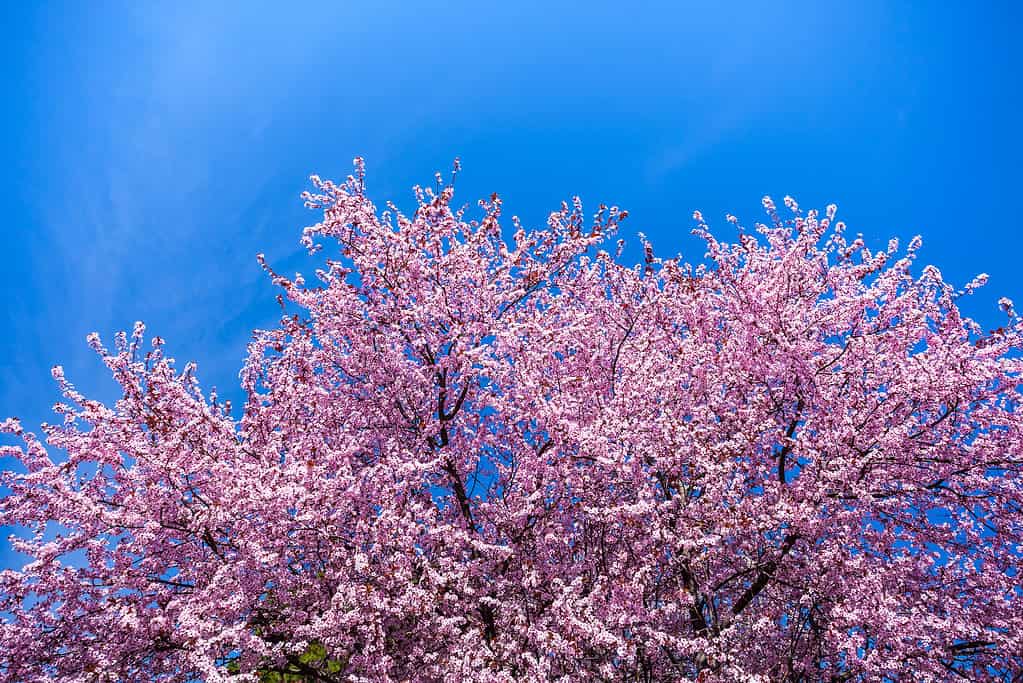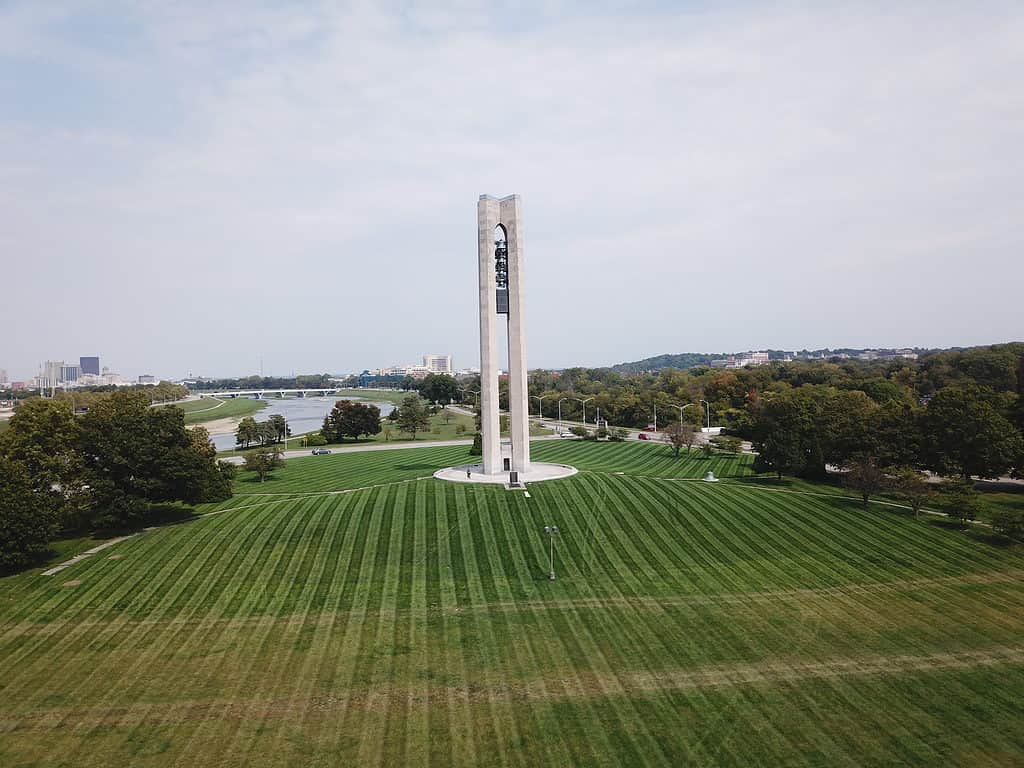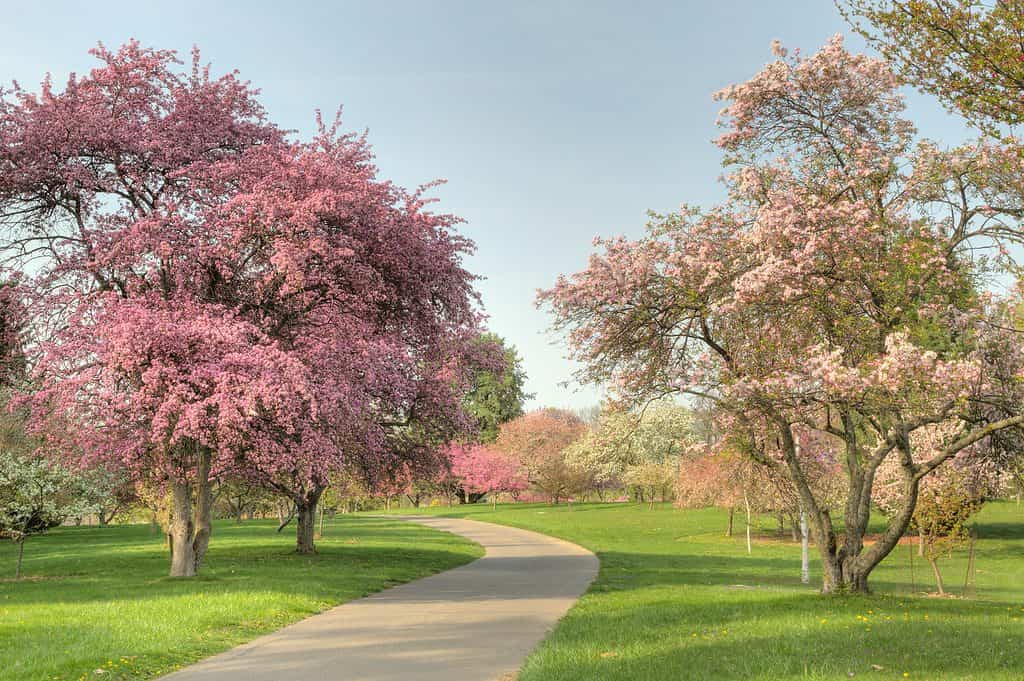Who doesn’t love the striking sight of cherry blossoms? The ornamental tree, also known as flowering cherry, Japanese cherry, or Sakura, is best known for heralding Spring with its confetti-like color burst.
You can’t miss the changing blossom colors, beginning as dark pink buds, lightening to pink when they first bloom, and finally becoming pale pink or white. The trees retain their allure throughout the summer after the late spring petals have faded because of their dark green foliage. In the fall, many trees display vibrantly colored leaves in amber, orange, and red hues. The winter months are a beautiful time to admire the lustrous, coppery bark long after the leaves have fallen.
Beyond the versatility of the tree that enables it to grace any landscape with vividly-hued flowers, the flowering cherry has a cultural and historical significance in some countries. It is an iconic imagery in Japanese culture. It is widely commemorated in Japanese poetry, literature, art, and even common consumer goods like stationery and dishware.
It’s common to find Sakura represented in contemporary anime and manga. In addition, flower viewing (Hanami in Japanese) parties are associated with welcoming the cherry blossoms.
They bloom en masse and hang over trees as though to envelop them in mist, giving rise to the idea that they resemble clouds. Afterward, they vanish abruptly, just like clouds. Thus, they represent the fleeting nature of life. This embodies a long-standing Buddhist philosophy in Japanese culture known as “mono no aware,” or loosely “the pathos of things,” which acknowledges the beauty and mortality of life.

Japan gifted the U.S. with cherry trees in 1912. What a lovely present!
©iStock.com/k_samurkas
Cherry Blossom History
In 1912, the United States received a gift of about 3,000 cherry trees in 12 different varieties from Japan. The trees were sent to replace the previous shipment of 2,000 trees that had to be destroyed in 1910 because of insect infestation. The new batch was planted along the Tidal Basin, East Potomac Park in Washington, D.C., and Sakura Park in Manhattan.
One Japanese cherry tree is a sight to behold in its full spring-blossom glory. To see hundreds blossoming in a single location? It’s a sheer delight! Thus, it’s hardly surprising that picnics and festivals are organized across the United States to celebrate the emergence of the iconic cherry blossoms.
Washington is home to the National Cherry Blossom Festival, so it’s naturally one of the best places in the country to see cherry blossoms in springtime. However, there are countless other places worth visiting. For instance, Branch Brook Park, managed by New Jersey’s Essex County, has been recognized for having the country’s most extensive collection of cherry blossom trees. States like Ohio have also benefited from the tree gift-giving of the Japanese.
The Buckeye state is lucky to have some locations where you may enjoy the lovely cherry blossom blooming in the Spring. You know, something vibrant to shake off the winter blues.

In the spring, Ohio is blooming with beautiful pink cherry blossoms.
©iStock.com/valerie
Where and When to See Cherry Blossoms in Ohio
The major cities in Ohio have distinct spots to see blooming cherry trees. Here are the top locations to visit when you want the perfect backdrop for your springtime adventure.
#1 Ohio University, Athens
People are drawn to the famous cherry trees at Ohio University every year because the city of Athens associates springtime with their blooming. However, the trees usually bloom from late March to early April. The university’s grove is situated between the campus and the Hockhocking Adena Parkway, and it typically houses cherry blossoms. In addition, a cycling route from the Hocking River to O’Bleness Hospital lines the grove.
A Japanese partner institution known as Chubu University sent 175 cherry blossom trees to Ohio in honor of the university’s 175th anniversary in 1979. In 2003, Chubu University offered a second contribution of over 100 trees right before Ohio celebrated its 200th anniversary.
The trees have been adequately maintained except for a few that suffered damage in the 2014 polar vortex.
The university’s Grounds Services and Landscape coordinator routinely replace and plant an average of five to seven new cherry trees yearly to preserve them.
A ceremonial lighting ceremony is held every year to usher the cherry blossoms. In addition, the university illuminates the region along the Hocking River and the Convocation Center in the evenings as the blooms enhance the aesthetics of the surroundings.

Ohio University sign in Athens, Ohio, is a lovely place to stroll about and see the cherry blossoms.
©Robert A. Powell/Shutterstock.com
#2 Brookside Reservation, Cleveland
Suppose the idea of picnicking under cherry blossom trees excites you. In that case, you don’t have to go all the way to the Tidal Basin or Mount Yoshino to make it a reality. The Brookside Reservation Park in Cleveland, northeast Ohio, is one spot you don’t want to miss. Over 100 Yoshino cherry trees are planted in tidy rows close to the entrance at Ridge Road.
Midway through the 1990s, Cleveland received these trees as gifts from the Japanese Association of Northeast Ohio. The trees are easily accessible and free on-street parking is available along John Nagy Boulevard. However, remember that you may need to park further down the road if it’s busy.
Blossom Lane is a popular path within the park to see trees dripping in exquisite blossoms.
The 132-acre park is one of the oldest parks in Cleveland and offers much more than cherry blossoms. You can explore the park for many other wildflowers.
In northeast Ohio, the cherry tree bloom typically happens between late March and early May. Still, the exact timing depends entirely on the weather. The lifespan of the blossoms after displaying their white and pink faces is between one and three weeks. They become more delicate the longer they bloom. Thus, wind, rain, or scorching weather can strip the trees once the blooms have passed their prime.
#3 Wade Lagoon
The picture-perfect, blue Wade Lagoon is an enchanting place to be in any season. To see it in Spring? A particularly fascinating experience. The Wade Lagoon and its vicinity come alive around late March to early May when the cherry blossoms are in peak bloom. Last year’s peak bloom was in April.
The trees decorate the scenery along the edge of the water. The views of the blossoms are just unbeatable.
It’s rightly known as the cultural heart of the Cleveland east side due to the surrounding presence of institutions such as the Cleveland Museum of Natural History, Cleveland Museum of Art, Severance Hall, and the Cleveland Botanical Garden. In addition, the lagoon, located in the University Circle, is a part of the larger Wade Park, which contains the Fine Arts Garden. Admission to the Cleveland Museum of Art is free, so it’s the perfect complement for your flower-viewing trip.
As you relax to take in the breathtaking view of cherry trees, you can look to the south for the magnificent structures of nearby buildings, including Case Western Reserve University.
The museums and attractions in Cleveland’s University Circle Neighborhood provide paid street parking and parking facilities nearby for visitors.

The picture-perfect, blue Wade Lagoon is an enchanting place to be in any season.
©Lucky-photographer/Shutterstock.com
#4 Towpath Trail, Akron
Beautiful cherry blossoms line Akron’s Towpath Trail every Spring between Ohio and Erie Canal Park and Lock 3, typically from late March to early April. A cross-cultural exchange between the city and the Japanese Association of Northeast Ohio resulted in the planting of over 400 cherry blossom trees between 2011 and 2012.
A stroll along the trail from Lock 3 to Channelwood Village on Thornton Street opens you up to the blossoming trees. Next, you can head out on foot or ride your bike along the Towpath Trail. Alternatively, Spaghetti Warehouse and the State St. parking deck offer free parking. The towpath is easily accessible from the warehouse’s parking lot, Lock 3, and the State St. trailhead entry (behind Canal Park Stadium).
This side of Akron is particularly enjoyable when the weather is good. After admiring cherry blossoms, you can spend the rest of your day in the park at Lock 3.
The Downtown Akron Partnership now hosts a Sakura Cherry Blossom Celebration every year. The last edition was held on April 9th, 2022.
#5 Bowling Green State University
There’s a fascinating history of the BGSU flowering cherry trees on the northern end of the Alumni Mall between the Harshman and Kreischer quadrangles.
The Tokyo-based alum group of BGSU had the idea to donate Sakura trees to their alma mater in the 1990s. The goal was inspired by the Potomac River cherry trees in Washington, D.C. It wasn’t achieved until 2001 when the Alumni group gave the university about 50 cherry blossom trees.
Tochigi-Fuji, a Japanese company formerly based in Bowling Green, donated 20 more trees the following year. Another company, Dowa THT America, presented the institution with 10 extra trees in 2010 to mark its 10th anniversary.
The campus has three direct descendants of the cherry blossoms Japan sent to Washington in 1912.
Away from these well-appreciated donations, over 4 dozen trees were planted for the inauguration of the new Alumni Mall. The BGSU Alumni Board of Trustees and BGSU alums in Japan worked together on the initiative to enhance the east side of campus.
The Japanese Club at Bowling Green State University and the Asian Studies Program usually organize the annual Cherry Blossom Festival in May. However, it was canceled in 2020 and held virtually in 2021.
#6 Carillon Historical Park, Dayton

Carillon Historical Park has been one of the top beneficiaries of the project. A cherry blossom trail connects the park with another iconic location in Dayton, the Dayton Art Institute.
©Kenneth Stedman/Shutterstock.com
In 2012, Japanese-born businessman Alex Hara initiated Operation 1000 Cherry Tree Project to appreciate the American response to the 2011 earthquake and tsunami that decimated his country of origin. The goal was to plant 1,000 cherry trees in and around Dayton. It was successfully achieved in 2017.
The project has been extended to plant 1,000 more trees and renamed Operation 2000 Cherry Tree Project. The trees cost $300 each, including planting and maintenance.
Carillon Historical Park has been one of the top beneficiaries of the project. A cherry blossom trail connects the park with another iconic location in Dayton, the Dayton Art Institute. You can visit the landmark open-air museum around April to catch the flowering cherries in bloom and explore the historic attractions onsite. The trees stay in color for about a week or two as they are relatively dependent on the weather.
You can also find cherry trees at the Dayton Masonic Temple, Edwin C. Moses Boulevard and South Patterson Street, and the National Museum of the U.S. Air Force.
#7 The Dawes Arboretum, Newark
The Japanese Garden at the Dawes Arboretum is a must-visit in April when flowering cherries are typically in bloom. Along with a scenic atmosphere, the garden also features bridges, a meditation house, and a pond. So is it just us, or this sounds like a perfect spot for yogis? You should go there to find out; it’s only about a 38-minute drive from Columbus.
Once you’ve had your fill at the garden, you can continue on the Auto Tour’s southern loop to see other varieties of trees.

The Japanese Garden at the Dawes Arboretum is a must-visit in April when flowering cherries are typically in bloom.
©Cynthia Kidwell/Shutterstock.com
#8 Franklin Park Conservatory and Botanical Gardens
In 2012, about 38 American cities were selected to receive 20 cherry trees from Japan. This was to commemorate the 100th anniversary of the trees shipped to Washington, D.C., in 1912. The trees allotted to Columbus were planted at the Franklin Park Conservatory and Botanical Gardens on April 27th.
Typically, the park collaborates with Japanese-American communities to celebrate the cherry blossom festival in April.
The photo featured at the top of this post is © iStock.com/shunichirou wakasugi
FAQs (Frequently Asked Questions)
Where is the National Cherry Blossom Festival?
Washington is home to the National Cherry Blossom Festival, so it’s naturally one of the best places in the country to see cherry blossoms in springtime. However, there are countless other places worth visiting.
How has the United States received cherry blossoms over the years?
In 1912, the United States received a gift of about 3,000 cherry trees in 12 different varieties from Japan. The trees were sent to replace the previous shipment of 2,000 trees that had to be destroyed in 1910 because of insect infestation. The new batch was planted along the Tidal Basin, East Potomac Park in Washington, D.C., and Sakura Park in Manhattan.
Thank you for reading! Have some feedback for us? Contact the AZ Animals editorial team.






